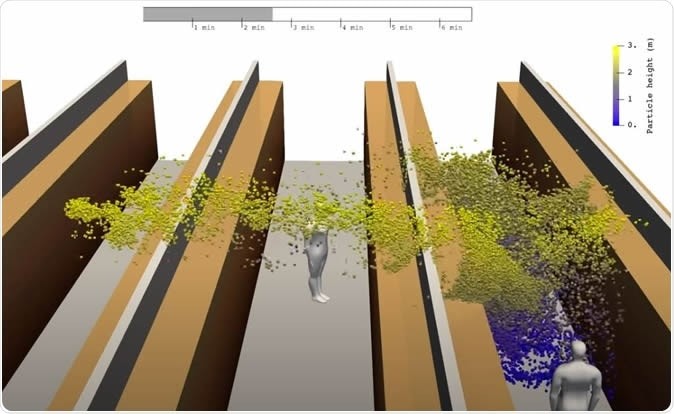Air Impact to Health – Viral infections acquired indoors through airborne, droplet or contact transmission.
An industrial hygienist not only looks at safety issue but also to address sources of environmental health concern. Imagine your office and home environment is like a sick building syndrome (SBS) akin to hospital acquired infections (HAI). Many institutions send in disinfection team as a quick fix. But how many times disinfection should be performed? A solution is to generate continuous air sterilization through air flow dynamics (CFD) in an air-conditioned environment regardless of the occupants’ presence. Breathing droplets circulated to a combined technology of UV-C lamps and photo catalytic oxidation (PCO) system will disable the RNA.
Scientists say there is evidence that airborne transmission in which the disease spreads in the much smaller particles from exhaled air, known as aerosols is occurring. When public health officials say there isn't sufficient evidence to say that COVID-19 is airborne, they specifically mean transported in virus-laden aerosols smaller than 5 micrometres in diameter. Compared with droplets, which are heftier and thought to travel only short distances after someone coughs or sneezes before falling to the floor or onto other surfaces, aerosols can linger in the air for longer and travel further. But the distinction between droplets and aerosols is unhelpful because “the particles that come out with virus can be a wide range of sizes. Aerosols are also more likely to be produced by talking and breathing, which might even constitute a bigger risk than sneezing and coughing. A study of people with influenza found that 39% of people exhaled infectious aerosols (Nature, 2020). As long as we are sharing airspace with someone else, breathing in the air that they exhale, airborne transmission is possible. Each breath might not produce much virus but capturing those small concentrations of aerosols that, given the right combination of airflow, humidity and temperature, might build to an infectious dose over time.
As scientists and health experts race to better understand COVID-19, new questions arise about what each of us can do to keep safe. How long does the coronavirus stay on certain surfaces? Is it airborne? Will there be a second wave? Should you be worried that your own air conditioning can spread coronavirus? Qingyan Chen, PhD, a Purdue University professor researching virus transmission through ventilation, says small droplets can be airborne transferred by air conditioning systems. Since most air conditioning systems cannot filter out very small droplets, the droplets could recirculate back to indoor spaces.
Airborne microorganisms (AM), vital components of particulate matters (PM), are widespread in the atmosphere. Since some AM have pathogenicity, they can lead to a wide range of diseases in human and other organisms, meanwhile, some AM act as cloud condensation nuclei and ice nuclei can affect the environment.
In a Finnish study based on modeling (Allto 2020), simulated the spread of aerosol particles from a person coughing in an aisle between shelves such as one found in a supermarket via air ventilation. The study shows how pathogenic aerosols can spread over a large distance and remain for a considerable period of time at different heights in the air, thus endangering others even after the infected individual has moved on.

Animation: Mikko Auvinen and Antti Hellsten
Disinfecting air and on surfaces
Air purifiers with high-efficiency particulate air (HEPA) filters remove not only particulate matter but also airborne microorganisms in indoor environments. As HEPA filters serve as an ecological niche for indoor bacteria, they should be carefully considered for indoor environment. An improved option is to use UV light particularly the shortest wavelength, known as UV-C kills viruses by damaging their DNA or RNA, crippling their ability to make copies of themselves. Hospitals have been using UV-C lamps and even UV-C robots to disinfect the air in rooms. But this light can also damage human cells, potentially harming the cornea, causing sunburn, and raising the risk of skin cancer. That’s why hospital staff turn on the lamps only when the rooms are emp.
Infection prevention is a banner cry by many epidemiologists concerned with reducing instances of healthcare-acquired infections (HAIs). Antimicrobial resistance is becoming a pressing issue as it results in drugs becoming ineffective and requiring increasingly harsher chemicals for surface disinfection. In this market, UV-C light has a proven track record being used to address air purification as far back as the early 1900s. In fact, there are instances of UV-C lamps still being employed for air purification in communal locations like waiting rooms, where sick patients interact with other patients and clinical care workers, thereby increasing the risk of developing multiple co-morbidities.
In the US, the Centers for Disease Control and Prevention (CDC) reported real improvements in controlling the incidents of HAIs using UV-C. The focus on portability places a premium on technologies that are compact, lightweight, such as sterilizing air without the harmful side effect of generating ozone in the process.
Some manufacturers of UV-C lamps have further developed photo catalytic oxidation (PCO) converters allowing for generating free ions when into contact with UVC Lights. The concentration of free ions dispersed in air which is known to bind physically and chemically with airborne contaminants (VOCs and airborne pathogens) rendering these contaminants inactive by changing their chemical structure. The free ions coming through the vents are also active to treat indoor air contaminants. Manufacturers of UVC Lamps provide lamp replacements after the useful life has elapsed (usually 12 months or 24 months). Some manufacturers combine filtration with UV-C/PCO technologies in one product and these are commercially available now.
References
https://pubmed.ncbi.nlm.nih.gov/29421410/?from_term="Air+Microbiology"%5BMAJR%5D&from_pos=2
https://pubmed.ncbi.nlm.nih.gov/32286482/
https://www.nature.com/articles/s41586-020-2271-3
https://www.aalto.fi/en/news/researchers-modelling-the-spread-of-the-coronavirus-emphasise-the-importance-of-avoiding-busy
https://www.washingtonpost.com/local/trafficandcommuting/scientists-think-they-know-ways-to-combat-viruses-on-airplanes-theyre-too-late-for-this-pandemic/2020/04/20/83279318-76ab-11ea-87da-77a8136c1a6d_story.html
